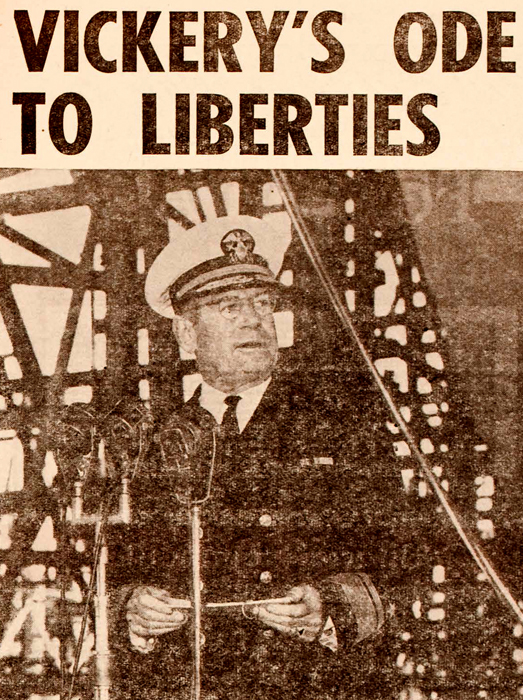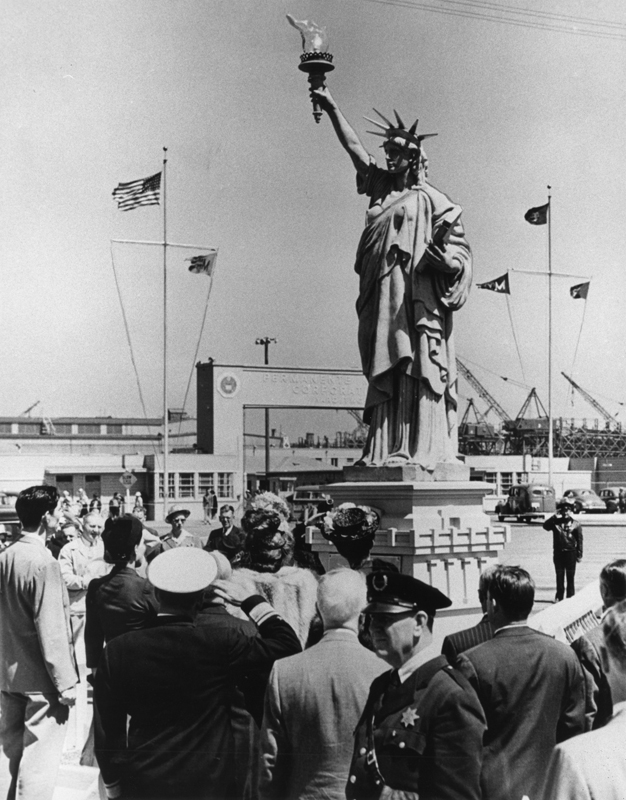Wartime ship launchings honored immigrants, African Americans, and labor leaders
Lincoln Cushing, Kaiser Permanente Archivist and Historian 2011-2021
Author's note: This article was originally posted on "A History of Total Health" blog 10/1/2017 and "unpublished" (likely due to a corporate communications perspective that it was too "out of scope" regarding strict messaging alignment regarding health care efforts) in late 2021, republished here as a public service 1/24/2022]
During World War II, diversity was an Allied media weapon against the Axis forces.
 Our diversity – our “melting pot” of ethnicities, races, religions, and
creeds – distinguished us positively from the purity and
exceptionalism espoused by our foes. The Office of War Information
promoted every instance in which our military and home front work force
reflected the rich mosaic that is America, and the Kaiser shipyards
offered fertile ground for content.
Our diversity – our “melting pot” of ethnicities, races, religions, and
creeds – distinguished us positively from the purity and
exceptionalism espoused by our foes. The Office of War Information
promoted every instance in which our military and home front work force
reflected the rich mosaic that is America, and the Kaiser shipyards
offered fertile ground for content.The Liberty ship Booker T. Washington, built at the California Shipbuilding Corp. at Terminal Island, Los Angeles and launched in 1942, was the first major U.S. oceangoing vessel to be named after an African-American. Several cargo ships were named after what we now call historically black colleges or universities, but back then were “Negro colleges.” When the SS Tuskegee Victory was launched at Oregon Shipbuilding on May 8, 1945, her invocation (a traditional elements of a ship launching, also known as the Prayer of the Invocation) was offered by Father Thomas Tobin, pastor of All Saints church, “who has championed the interests of minority groups all his life.”
The second ship named after an African-American was the SS George Washington Carver, built in the Kaiser Richmond shipyard. She was the first Kaiser-built Liberty ship to be named for a famous African-American, and many of the men and women who built her were African Americans.
The SS Pendleton was the 49th “T2” model tanker built at the Kaiser Swan Island shipyard, on the Willamette River in Portland, Oregon; her launching at the beginning of 1944 honored the role of Native Americans in the military and the home front.
 Six Liberty ships were named for labor leaders, many of whom were
European immigrants. And seven other Liberty ships launched in 1944
were named for Jewish American labor leaders, doubly sticking it to
Hitler’s doomed Reich.
Six Liberty ships were named for labor leaders, many of whom were
European immigrants. And seven other Liberty ships launched in 1944
were named for Jewish American labor leaders, doubly sticking it to
Hitler’s doomed Reich.The launching of the SS Benjamin Warner on the 4th of July weekend, 1944, honored an immigrant, and the event was decorated with a giant replica Statue of Liberty. America’s film industry became a testament to the Allied moral high ground, as a place where even Polish Jewish immigrants could rise to fame and fortune.
The Warner was named after the father of Hollywood’s Warner brothers. Henry J. Kaiser, himself the child of immigrants, proclaimed “Benjamin Warner was a plain man, unknown and unsung until he entered the new world of hope and opportunity which he found in America.”
She was the 1,147th ship of this class built in the Kaiser shipyards and launched on the West Coast—and the last. A few Liberties are still being finished at East Coast yards. The Liberty class was being replaced by the larger and faster Victory class ships, and the Kaiser shipyards were already building them. A reporter for Time magazine described the event as “the melancholy end of a shipbuilding era.”
Benjamin Warner’s sons, Hollywood motion picture producers Harry M. and Colonel Jack Warner, were present at the ceremonies. The craft was sponsored at the launching by Miss Lita B. Warner, 19-year-old granddaughter, a Stanford University student.
Rabbi Rudolph I. Coffee conducted the Warner’s invocation. Between 1921 and 1933, Coffee had been the rabbi at the oldest Jewish congregation in the East Bay, Temple Sinai, 28th and Webster streets. After that he became the chaplain at San Quentin Prison until he retired in 1954. Rabbi Coffee had been selected for this honor because he’d performed wedding ceremonies for Harry Warner and his third brother, Albert.
A 13-foot-tall replica of the Statue of Liberty was unveiled as a gift from Warners to the builders at shipyard #2. The fate of this replica is unknown.
Yes, send us your huddled masses yearning to be free. Modern diversity messaging favors the “salad bowl” concept rather than the “melting pot,” but the concept is the same – In addition to making us stronger, diversity and inclusion enable us to achieve the vision our founders had when they started it all.
A short news film by Paramount Pictures of the launching can be seen here.
Return to Docs Populi - Documents for the Public